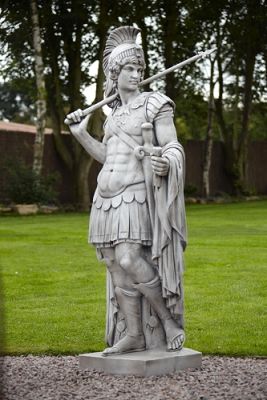

On top of all this, centurions also wore the awards they had received for valour, which could include heavy necklaces ( torques), bracelets ( armillae), and medallions ( phalerae), which were worn attached to a leather chest harness. In the Imperial Period, oval shields could be carried, but generally the centurions seem to have used the same shield type as the troops under their command. The typical shield in the Roman Republic was either the circular clipeus or the rectangular scutum. A centurion also carried a 90 cm vine-stick cudgel ( vitis latina) as a measure of his rank. A cloak ( sagulum) could be worn, which was typically blue or green with a yellow border and tied at the front using a brooch or fibula. A tunic was worn under the armour, which for centurions was either white, off-white, or various shades of red. In the 1st century CE, a short-sleeved ringmail armour vest was also common amongst centurions. Chest (and back) armour could also have shoulder guards ( humeralia) and protective hanging strips ( pteryges) for the upper arms and groin and even a neck protector at the back. Alternatively, he could wear a leather version or lighter stiffened linen cuirass ( linothorax). His armour included greaves ( ocreae), which usually had engraved decoration, and a bronze cuirass ( thorax stadios) chest plate, either belly-shaped or sculpted to replicate muscles or incorporating scaled armour ( lorica squamata). In the later Roman Empire, centurion helmets carried insignia in silver. Early centurion helmets could also have a faceguard or mask sculpted into the form of, for example, a horned Silenus. In the Imperial Period, the crest could also be front to back on the helmet. Uniform & ArmourĬenturions often wore a helmet ( galea) with a distinctive transverse crest ( crista transversa), which was typically silver with a died hair or feather plume, typically ostrich or peacock feathers. 69-79 CE) father and grandfather had also served as centurions. 198-217 CE), showed that in turbulent times even the highest position of all was possible, and Vespasian's (r. 235-238 CE), a centurion under Caracalla (r. On the other hand, and although most centurions maintained that rank throughout their career, it now became possible for senior centurions to go even higher in the hierarchy and become tribunes, prefects, and even members of the Senate. Their titles of prior and posterior were also maintained, as was their seniority based on which type of troops they commanded - (from the least senior) hastati, principes, and pili (younger, experienced, veteran troops, respectively) and the seniority of their centuriae within a particular cohort.Īs the Roman army became ever more professional, so too the requirements to become a centurion became stricter and, at least for the most senior centurion positions, a certain ability in administrative affairs became necessary, even the support of an influential patron. Each legion had ten cohorts so that the number of centurions in a legion remained 60. Centurions usually took position in the front rank of their troops during battle, which resulted in their disproportionate fatality rate in battle.īy the 1st century BCE, the army was re-arranged into cohorts ( cohors), each consisting of six 100-man centuriae. Following Marius' reforms in 107-104 BCE, the centurion given command of the right centuria of the maniple was known as the prior centurio, whilst he on the left wing was called the posterior. Of all these centurions, the most senior was the primus pilus, who also had a seat on the military council. Two centuriae made up a maniple and the most experienced centurion took the right wing. The legion in this period was divided into 30 manipuli with a total of 60 centuriae units each commanded by a centurion who appointed his own junior officer ( optio). Polybius describes the army units of the mid-2nd century BCE where there were 4,000 men to a legion that now included light skirmishers. Centurions were expected to lead by example & display the greatest courage on the battlefield.


 0 kommentar(er)
0 kommentar(er)
